IPv4 (Internet Protocol Version 4) is the fourth version of the Internet Protocol (IP) used to identify devices on a network through an addressing system.
While the internet has grown beyond its initial scope, necessitating the creation of IPv6, IPv4 remains a crucial element of the global internet.
This protocol's mastery is not just academic; it's essential for networking professionals and enthusiasts aiming to diagnose network issues, optimize performance, and bolster security.
Understanding the IPv4 packet header, which encapsulates the data sent over the internet, is fundamental. This header contains critical information that helps routers send packets from the source to the destination efficiently and accurately.
In this article, we delve deep into the IPv4 packet header, dissecting its structure and the significance of its components in data transmission. By the end of this exploration, readers will appreciate the intricacies of the IPv4 protocol and how it underpins much of our daily internet use.
Understanding the IPv4 Packet Header
The IPv4 packet header is like a guide for data as it travels across the internet. Let's break down its parts using simple English, highlighting the key components that make data transmission smooth and secure.
Version
This is the first part of the header. It tells us which version of the Internet Protocol (IP) is being used. For IPv4, this is always set to 4. This ensures that the systems handling the data know how to process it correctly.
Internet Header Length (IHL)
The IHL tells us how long the header is. Since not every header is the same size, this part is crucial. It's measured in 32-bit words. The minimum size is 20 bytes, but it can be longer if there are more options added.
Type of Service/Differentiated Services (DS)
This part deals with how the data should be treated as it moves through the network. It helps in prioritizing traffic, ensuring that more critical data (like video calls) can move faster than less urgent data (like email).
Total Length
It shows the total size of the packet, including both the header and the data. This helps routers understand how much data they're dealing with, which is essential for managing network traffic efficiently.
Identification, Flags, and Fragment Offset
These parts work together when a packet is too big and needs to be split up. They help ensure that all the fragments can be reassembled correctly at the destination, making sure nothing gets lost or mixed up.
Time-to-Live (TTL)
TTL prevents packets from getting stuck in a loop, going around the internet forever. It's a counter that decreases by one every time a packet passes through a router. If it reaches zero, the packet is discarded, stopping endless loops.
Protocol
This field tells the system what kind of data is being sent (like web pages, emails, etc.) and ensures that the data gets processed by the right protocol (like TCP for web pages) when it arrives at its destination.
Header Checksum
The checksum helps check that the header hasn't been damaged or altered during its journey. If the checksum doesn't match up at the destination, the packet is considered corrupted and is discarded to prevent errors.
Source and Destination Addresses
These are the IP addresses of the sender and receiver of the packet. They make sure the data knows where it started and where it's going, much like an address on an envelope.
Options (if present)
This part is not always used, but it can include extra information needed for specific situations, like special routing instructions or security features.

Practical Applications and Importance
Diagnosing Network Issues
One of the most critical skills for IT professionals is troubleshooting network problems. By understanding the IPv4 packet header, you can quickly pinpoint where things might be going wrong. For example, if a packet's Time-to-Live (TTL) value reaches zero before it arrives at its destination, this could indicate a routing loop. Similarly, examining the header checksum can help identify corrupted packets, which are a common issue in data transmission errors.
Enhancing Network Security
Security is a top priority in any network. Knowledge of the IPv4 packet header can significantly contribute to enhancing security measures. By analyzing the source and destination addresses, IT professionals can detect and mitigate potential threats, such as spoofing attacks where an attacker attempts to deceive the system by altering the packet header information. Additionally, understanding options in the header can help in implementing security features like IPsec (Internet Protocol Security) for encrypting and authenticating IP packets.
Optimizing Network Performance
Network performance can be significantly improved by optimizing the settings in the IPv4 packet header. The Type of Service/Differentiated Services (DS) field, for instance, can be adjusted to prioritize certain types of traffic, ensuring critical applications have the bandwidth they need. This Quality of Service (QoS) management is crucial in networks carrying a diverse mix of traffic, including real-time voice and video, alongside more latency-tolerant applications like email.
For students and aspiring IT professionals, mastering the IPv4 packet header is foundational. Courses like our Cisco CCNA not only cover the theory behind IPv4 but also provide practical, hands-on experience. This real-world application is invaluable, preparing learners for the challenges they'll face in their careers.
Summary
Understanding the IPv4 packet header is more than a technical skill—it's a necessary foundation for anyone involved in networking and IT.
This blog has walked you through the complexities of the IPv4 packet header, highlighting each component's role in ensuring efficient, secure, and reliable data transmission across the internet.
From troubleshooting network issues to enhancing security measures and optimizing network performance, the knowledge of IPv4 packet headers is indispensable.
Dive deeper, practice, and never stop learning. The digital world is evolving, and with it, the tools and technologies at our disposal. Staying informed and skilled is the best way to ensure you're always ready to tackle the challenges and opportunities that lie ahead in the field of IT and networking.


